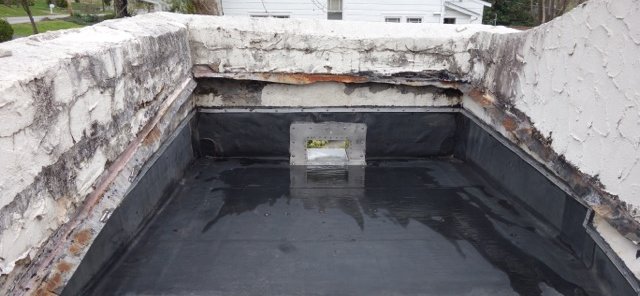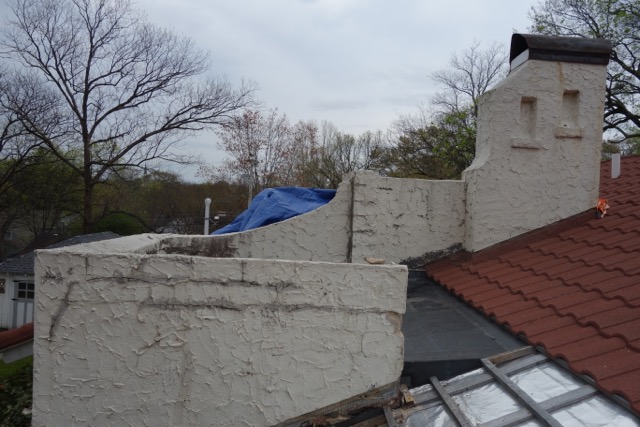Stucco Parapet wall
This wall isn't in real bad shape. It can be chipped and re coated.
You have given me some advice via email before that has been greatly appreciated. Since I live in Chattanooga, and well outside of your working range, I would like to know if I could hire you as a consultant to help me get my jobs done. I have several items that need to be addressed, and the local stucco companies I have contacted have not inspired confidence. I have a 1930’s Mediterranean style home that is textured stucco over block, and the jobs range from repairing cracks and holes, to covering parapet walls and replacing an ~5’ x 6’ ceiling over our front door entrance way. I can take pictures and provide detailed information for you to work from, and am confident in being able to complete the jobs with proper direction.

The first step is to flash over the terminator bar on the rubber membrane roof.
Water will penetrate the stucco and trickle down behind the membrane.
Trust me here on this one. We fix a lot of leaks. It doesn't have to be done as fancy as we did here: Flashing rubber membrane roofs for stucco, but it needs to be done. A strip of sheet metal flashing will work, provided it overlaps the edge of the membrane a couple inches or so, and is nailed to the block. The idea is that the flashing overlaps the block, and the casing bead overlaps the flashing. This doesn't need to be beautiful because you can't see it from the ground.
You'll need: an angle grinder. You can get one from Harbor Freight for about $ 16. Also you need discs: a diamond or carbide blade for cutting stucco, and a grinder disc for sharping your chisels for chipping the stucco. While you are at Harbor Freight, you may want a chipping hammer, known as a rotary SDS. This is for chipping the stucco. This small an area can be chipped with a hathet or a chisel, but a chipping hammer is a lot faster.
At Home Depot or wherever, you can get a roll of aluminum flashing, 7" wide is fine, a tube of black goo for sealing over the flashing and the rubber membrane, and some nails. We usually use ramset pins for nailing masonry. 1 1/4" are fine for naing to the masonry.
There should be a building supply in your area that has casing bead, also known as plaster stop, or #66 casing bead. A large drywall supply should be able to hook you up. This comes in 10 foot lengths, you want 3/4" bead, enough for the inside of the parapet, and over the flashing on the outside that is already flashed for your Spanish Tile roof.
The procedure is to cut back the stucco a few inches above the membrane down to the block like we did here: Flashing rubber membrane roofs for stucco.You can overlap the top of the membrane a couple inches and nail it as high as you can and seal the top with black goop. The next step is to nail the casing bead overlapping the flashing as high as you can. If the nails don't stick real good it doesn't matter. This won't wiggle when you put on the stucco.

The reason the stucco is failing is due to a lack of coping.
Angling the mortar on top may be OK for a knee wall or a retaing wall, but I wouldn't do this on a house. Even though the coping goes on last, after the stucco, you may want to make provisions now for how it is attached.
I do coping time to time, and I can use a metal brake, but I am not an experienced sheet metal worker. This is something you don't want to do yourself so you want to find an experienced roofer. The coping doesn't need to go on right away, and you can put on a temporary coping when you are finish ed with the stucco.
A nailer for the coping can be 1/2" thick furring strips nailed or anchored to the top of the wall. I figure your finish thickness will be 1/2" over your old stucco. These can be strips 1/2" thick and about a inch and a half wide. A 3/4" strip won't hurt because you have a rough texture. You may also bolt 2 by's to the top of the wall, extending out 1/2" for your stucco thickness, like we did here: Block parapet wall
For the stucco you'll need Type I Portland, masonry lime, flex-con and sand. Your local supply should be able to hook you up with the lime. Enough for now, Write me back when you are ready.